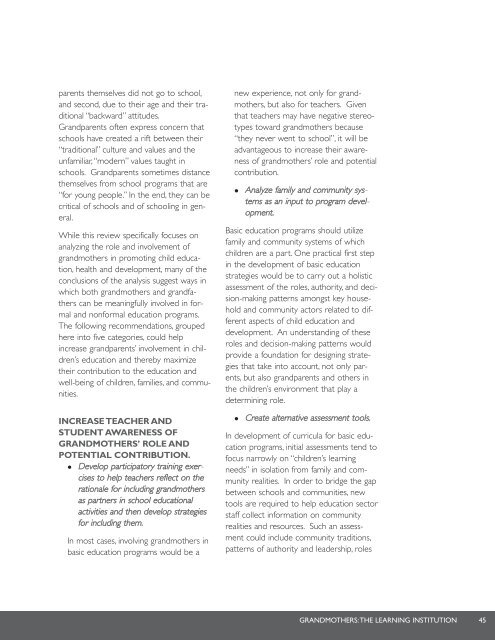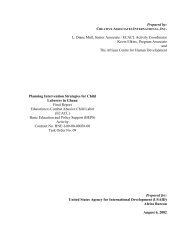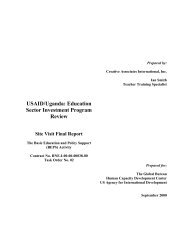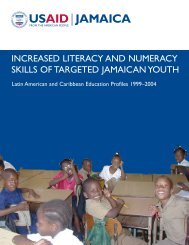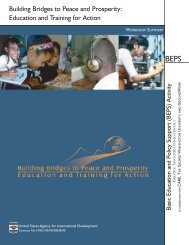Grandmothers: A Learning Institution - Basic Education and Policy ...
Grandmothers: A Learning Institution - Basic Education and Policy ...
Grandmothers: A Learning Institution - Basic Education and Policy ...
- No tags were found...
You also want an ePaper? Increase the reach of your titles
YUMPU automatically turns print PDFs into web optimized ePapers that Google loves.
parents themselves did not go to school,<strong>and</strong> second, due to their age <strong>and</strong> their traditional“backward” attitudes.Gr<strong>and</strong>parents often express concern thatschools have created a rift between their“traditional” culture <strong>and</strong> values <strong>and</strong> theunfamiliar,“modern” values taught inschools. Gr<strong>and</strong>parents sometimes distancethemselves from school programs that are“for young people.” In the end, they can becritical of schools <strong>and</strong> of schooling in general.While this review specifically focuses onanalyzing the role <strong>and</strong> involvement ofgr<strong>and</strong>mothers in promoting child education,health <strong>and</strong> development, many of theconclusions of the analysis suggest ways inwhich both gr<strong>and</strong>mothers <strong>and</strong> gr<strong>and</strong>fatherscan be meaningfully involved in formal<strong>and</strong> nonformal education programs.The following recommendations, groupedhere into five categories, could helpincrease gr<strong>and</strong>parents’ involvement in children’seducation <strong>and</strong> thereby maximizetheir contribution to the education <strong>and</strong>well-being of children, families, <strong>and</strong> communities.INCREASE TEACHER ANDSTUDENT AWARENESS OFGRANDMOTHERS’ ROLE ANDPOTENTIAL CONTRIBUTION.• Develop participatory training exercisesto help teachers reflect on therationale for including gr<strong>and</strong>mothersas partners in school educationalactivities <strong>and</strong> then develop strategiesfor including them.In most cases, involving gr<strong>and</strong>mothers inbasic education programs would be anew experience, not only for gr<strong>and</strong>mothers,but also for teachers. Giventhat teachers may have negative stereotypestoward gr<strong>and</strong>mothers because“they never went to school”, it will beadvantageous to increase their awarenessof gr<strong>and</strong>mothers’ role <strong>and</strong> potentialcontribution.• Analyze family <strong>and</strong> community systemsas an input to program development.<strong>Basic</strong> education programs should utilizefamily <strong>and</strong> community systems of whichchildren are a part. One practical first stepin the development of basic educationstrategies would be to carry out a holisticassessment of the roles, authority, <strong>and</strong> decision-makingpatterns amongst key household<strong>and</strong> community actors related to differentaspects of child education <strong>and</strong>development. An underst<strong>and</strong>ing of theseroles <strong>and</strong> decision-making patterns wouldprovide a foundation for designing strategiesthat take into account, not only parents,but also gr<strong>and</strong>parents <strong>and</strong> others inthe children’s environment that play adetermining role.• Create alternative assessment tools.In development of curricula for basic educationprograms, initial assessments tend tofocus narrowly on “children’s learningneeds” in isolation from family <strong>and</strong> communityrealities. In order to bridge the gapbetween schools <strong>and</strong> communities, newtools are required to help education sectorstaff collect information on communityrealities <strong>and</strong> resources. Such an assessmentcould include community traditions,patterns of authority <strong>and</strong> leadership, rolesGRANDMOTHERS:THE LEARNING INSTITUTION45


